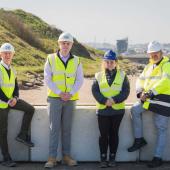Possibilities of 3D printing
From bridges to bespoke draw pits and even houses, 3D printed concrete is everywhere.
While the construction industry in the UK works toward net zero by 2050, back in 2018, Dubai announced that 25% of the emirate’s new construction projects would be 3D-printed by 2030. Plans are now underway to construct the world’s first 3D-printed mosque, which will accommodate 600 people. And, while developments such as this will no doubt showcase the elaborate usage of the material, more modest buildings have been created to tackle the housing crisis and an ongoing shortage of affordable housing in many nations across the globe.
In 2018, Texas-based company ICON was a start-up – today it’s 3D printed more than 100 homes across the US and Mexico. Co-founder, Jason Ballard says: “to address the global housing crisis, something radical and courageous needs to happen. Construction-scale 3D printing is designed to not only deliver high-quality homes faster and more affordably, but fleets of printers can change the way entire communities are built for the better.”
Its projects include 3D-printed homes in Tabasco, Mexico to house local families experiencing extreme poverty. Each home measures 500sq ft (46.45m2) and includes two bedrooms, a living room, kitchen, and bathroom and was printed in around 24 hours.
At the opposite end of the scale, you can view ICON's current listings of properties such as the magical-sounding Wolf Ranch in Georgetown, Texas where homes cost upwards of 500,000 dollars with eight floorplans and 24 elevations to choose from. You can add your name to a waiting list for homes not yet built. Icon developed a material called Lavacrete, a high-strength concrete that can be printed quickly meaning it takes less time to build homes. It’s said to have a compressive strength of 2,000 - 3,500 psi.
In the UK, we’re yet to see any 3D printed houses although plans are underway for 46 affordable and net zero carbon homes in Lancashire as part of a collaboration between Homes for Humanity and HTL Tech who are partnered with Danish company COBOD (who built the first fully compliant 3D printed house in Europe in 2017). Remarkably, it’s predicted that it will take just 100 days to complete the printing including load-bearing and non-load-bearing walls.
All proof that 3D printing concrete can be affordable, versatile, and time-efficient. So, it’s surely only a matter of time before we too can join a waiting list for a home that could effectively be constructed in a matter of days rather than weeks or months, too?
I'm excited to see how it develops over the next decade.







